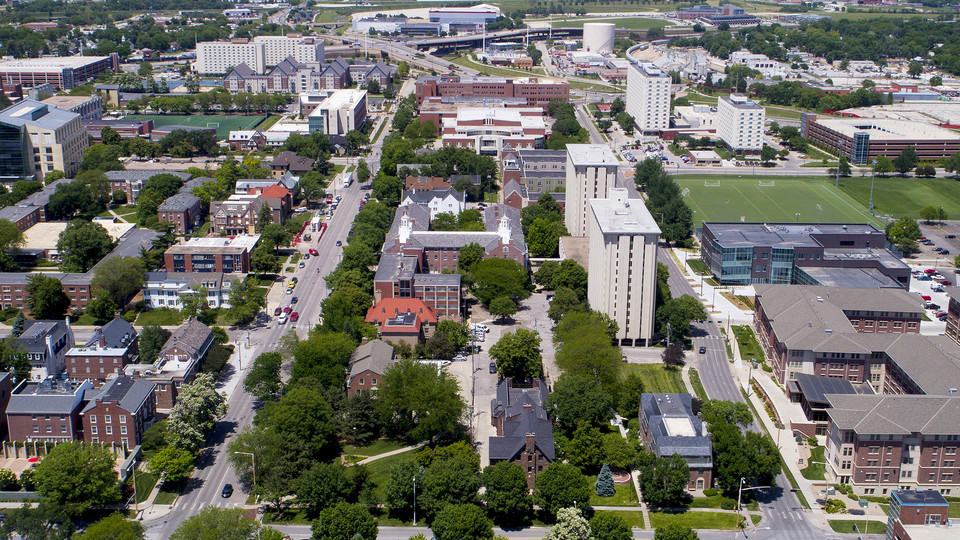· 4 min read
Project to shift traffic flow through City Campus

A summer construction project will permanently shift traffic patterns and expand bike commute options through the heart of the University of Nebraska–Lincoln’s City Campus.
The project, which is guided by a partnership between city and university leaders, will permanently close a three-block stretch of 17th Street, transition 16th Street to two-way traffic through campus, and add bike lanes along Vine and 16th streets. The work is an extension of the university’s master plan, which aims to position parking and direct vehicle traffic toward campus edges, and Lincoln’s Antelope Valley project.
“This continues ongoing efforts to increase safety and enhance the pedestrian nature of campus,” said Jennifer Dam. “The work will primarily be new pavement markings and replacing some traffic signals with stop signs. It is scheduled for completion ahead of the fall semester.”
The project will bring major changes to 16th Street, transitioning three lanes of one-way, southbound traffic between Q and X streets to two-way traffic with one lane southbound and another lane northbound. The reconfiguration will also include the addition of dedicated bike lanes in each direction and parking spaces along both sides of the roadway.
>>Click here to view a map outlining project details
Changes to 16th Street traffic flow are being made as 17th Street — a one-way that directs vehicles north through campus — will close between Vine Street and the service road (near S Street) on the north side of Knoll Residential Center. South of the service road, 17th Street will become a two-way to Q Street. Dam said the project will incorporate a drop-off area in front of the Courtyards Residence Hall complex at 17th and Vine streets. The closure is pending approval by the Lincoln City Council.
“For the most part, 17th Street will be permanently closed between Vine and R streets,” said Mark Lutjeharms, senior traffic engineer for the City of Lincoln. “The city is vacating this stretch of the public street and it will become university property.”
The closed stretch of 17th Street will become a pedestrian mall similar to those that exist on City Campus along 12th and 14th streets — both of which were once traffic lanes.
Lutjeharms said the design calls for two six-foot-wide bike lanes on either side of the traffic lanes with metered parallel parking — which already exists — along the curb. The 16th Street design will also incorporate designated loading zones for buildings along the roadway.
Due to reduced traffic volume, seven traffic signals will be removed as part of the work. Those signals include: 16th and R streets; 16th and S streets; 16th and Vine streets; 16th and W streets; 17th and R streets; 17th and Vine streets; and the 17th Street pedestrian crossing near S Street.
Intersections at 16th and Vine, 16th and R and 17th and R will become four-way stops; 16th and S, and 16th and W will become three-way stop intersections; and east-west traffic will move without stopping through 17th and Vine streets.
Along with increasing pedestrian safety on campus, the project will also reduce roadway and traffic signal expenses for the city.
“It costs between $5,000 and $7,000 per year to operate and maintain a single traffic signal,” Lutjeharms said. “One of the many benefits of this project to the city is that it will save us a fair amount in operation and maintenance costs.”
The project will also add bike lanes along the edges of Vine Street, connecting existing community bike paths near Antelope Valley Parkway, to City Campus at 16th Street.
City and university officials continue to work together to finalize details of the project.
Changes on 16th Street north of Vine Street will begin once a chilled water main project is complete. The majority of the work will begin after July 17.
Lutjeharms said the changes to 16th, 17th and Vine streets will be completed by mid-August.
“This is a project that will calm traffic moving through campus, increase public safety and reduce annual maintenance costs for the city,” said Lutjeharms. “It is the definition of a win-win situation for everyone involved.”







